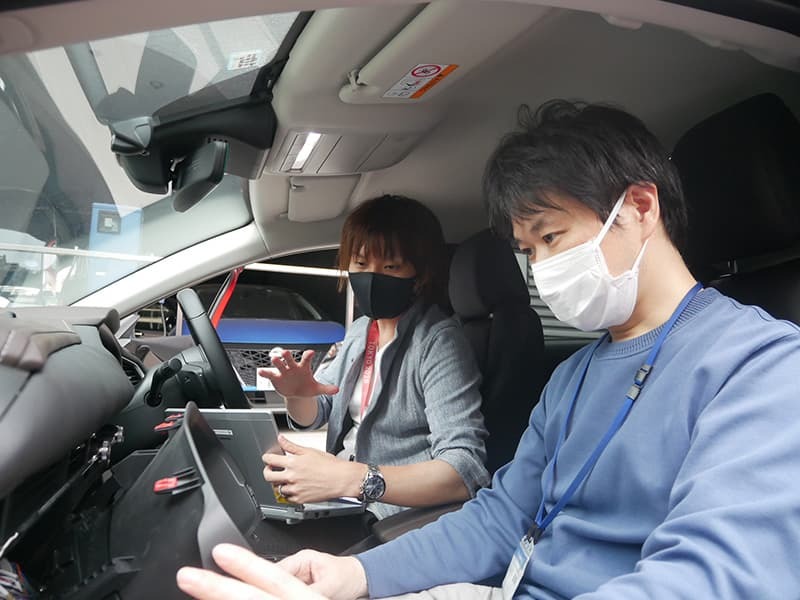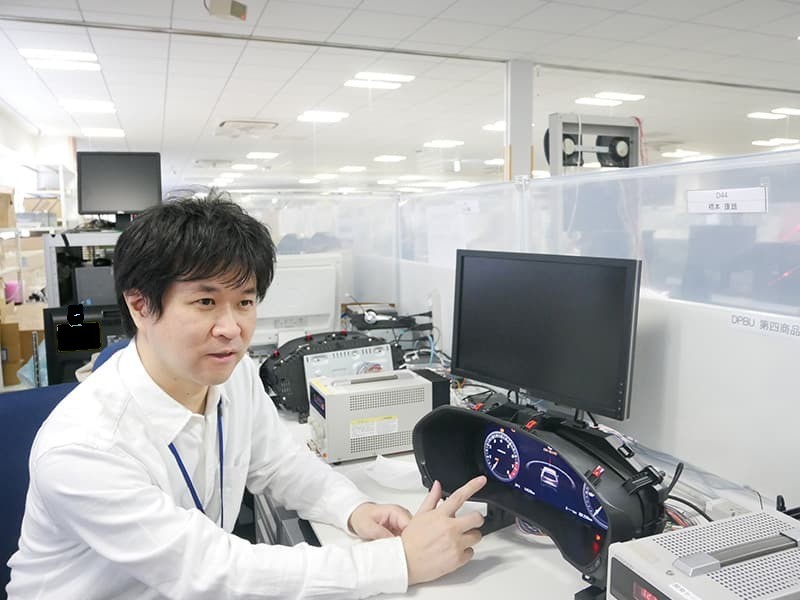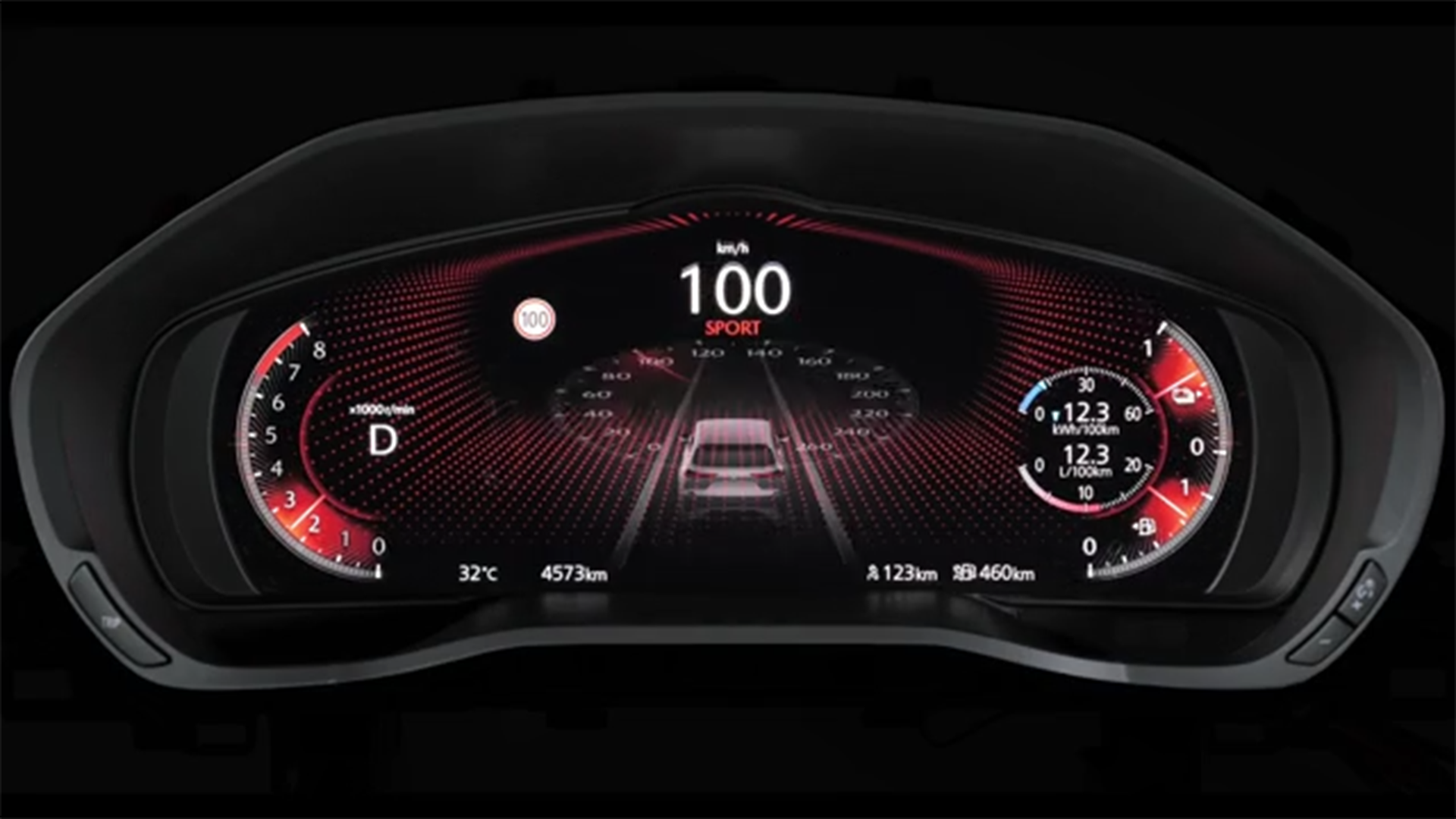Newsroom
Utilizing 3D Graphics and Customer Organizational Skills to Provide a New Experience
Technological Development of Full-Display Meters

Products offered by Automotive Systems are used in every part of the automobile, from small parts such as in-vehicle cameras to key components such as mirrors. However, these products cannot be created overnight. Many people and organizations are involved in each product, working through trial and error every day to create products that are better today than they were yesterday, and better tomorrow than today.
Full-display meters are one of these products. This is the first product to be selected and installed at a car manufacturer, and it is designed from scratch by the development team, with support from various organizations, including the R&D Division, to create a single product. The product we produce is an in-vehicle components that does not function by itself, but we will show you how we pursue product value in order to provide even more comfortable mobility in cars, where safety and reliability are the first priority.
What can only Panasonic propose, leaving behind conventional concepts?
The cockpit, which provides forward speed and warning displays to the driver of the car, is the most important interior area for safe and reliable driving. The full-display meter with high-definition and high-resolution display visualizes the vehicle condition, which is particularly important. It is now installed in the CX-60, which Mazda is proud to offer, and is one of the elements that enhances the driving pleasure of the vehicle.
Development of a full-display meter with Mazda began in 2016. To propose a new cockpit solution not limited by existing products and approaches, we began to consider whether we would be able to propose a display meter, which we had not worked on before, using our technological capabilities. Previously, it was common practice to physically display speed and tachometer readings with mechanical needles. Other companies with proven product performance in this field were overwhelmingly dominant. It would be too risky to launch a similar product in this same market, so the development team continued to consider whether a different approach could lead to new products to propose to car manufacturers.
From that time, Mazda has been focused on incorporating sophisticated expression and coolness. While of course meeting the absolute requirements of communicating vehicle status to the driver, such as speed and warning displays, the full-display meters also provide coolness that other cars can’t match. How can we support Mazda in communicating this dedication to car users? Furthermore, what can only Panasonic do to enhance the joy of driving while displaying information in a way that is easy to recognize?
After meeting internally and with Mazda day after day and night after night, the development team found a solution in 3D graphics technology by leveraging the existing expertise of team members in game graphics and in-vehicle built-in technology.
We have realized that we could gain user recognition for new value that creates a sense of excitement and high spirits while driving through animated transitions using the entire display and mode selection according to user preferences, which was not possible when mechanical needle meters were used to display speeds, and by expressing these using 3D graphics.
Based on this assumption, the development team continued to work steadily on the proposal while also showing a prototype of a full-display meter in a technological exchange with Mazda. As a result, our meters have been used since 2020, in recognition of our technological capabilities to clearly display 3D graphics, including display of surrounding vehicles and lanes.
Video 1 (Opening)


Working with customers to make continuous improvements
However, a major obstacle stands in the way of concrete product design from this point. Important hazard indication as a warning display. For a typical automobile, the flashing of the lights at the bottom of the side mirrors and the tail lights in perfect synchronization with each other is an essential specification. The hazard indication located on the full-display meter needs to be synchronized, too. Due to the decoration of the display, the CPU load factor increased, causing a shift in the blinking display. Configuring the content according to the specifications required by Mazda, meant that we could not clear up this issue. First, we conducted a series of architectural improvement reviews to reduce the number of data updates and the volume of data as much as possible. Meanwhile, we worked with Mazda to adjust the graphics display, balancing the CPU load rate with the 3D and 2D expressions, so that we could maintain functionality that would satisfy Mazda. At the same time, to correct software bugs that appeared every time adjustments were made and improve performance, the cycle of finding areas for modification, software modification, and mutual checking with the customer had to be performed as quickly as possible, or the vehicle would not be ready for launch.
“Looking back, the peak of our work was while repeating this cycle.” said Mr. Tsukada, head of development, and Mr. Takada, development leader.

Here, we will overcome the challenges with the capabilities of our organization. The development team is located in Yokohama and Mazda is located in Hiroshima, far from each other. It is difficult to communicate subtle nuances in online meetings, which makes communication difficult and tends to bury issues and risks. Then, in cooperation with the sales team in Hiroshima, Mr. Takada, the leader of the team, formed a dedicated team in Hiroshima to communicate closely with the customer. This helped us to make comprehensive improvements to meet Mazda's requirements by implementing a cycle whereby the development team in Yokohama would update software on the same day that modifications were necessary, share the updates with the dedicated team in Hiroshima, and present the proposed modifications to Mazda directly in person as early as the next day.
In addition, since the product had never been used before, we collaborated with the R&D Division to share knowledge of compliance with laws and regulations required for safety design and clarification of behavior definitions in the event of a failure, and pursued specifications that would meet safety design standards for full-display meters, which are safety part commercial products.
Video 2 (When Vehicle Is Running)

Proposing further cockpit solutions
The CX-60 for Japan was released for sale on September 15, 2022 and has received favorable feedback from Mazda car users.
“We have received compliments on this development, which would not have been possible without Panasonic.” said Mr. Tsukada.
“We had no previous experience with display meters, so we actually had to develop the product from scratch, and worked with Mazda on the details of the product. To further differentiate ourselves, we would like to work with car manufacturers to provide value to users that makes them excited about driving.”

Related Links
Click here for the press release “Full-display meter installed for Mazda Motor Corporation's CX-60”
Click here for the Mazda Motor Corporation website https://www.mazda.co.jp/cars/cx-60/
Developer's Voice

Mr. Yasuhiro Takada,
Product Development Section 3, Product Department 4,
Display Business Unit, HMI Systems Business Division
“This time, Mazda has recognized our technologies and we have been working together to build something concrete through co-creation activity. I believe that the two companies were able to create a good product by thinking together about how to best approach the requirements, and the ideas of both companies are embodied in the product.
We hope to use our graphics technologies to create exciting expressions that will create new value for full-display meters in the future and contribute to the expansion of the meter business.”
Video 3 (Mode Switching)

Video 4 (Driving Assist System Information Screen)


